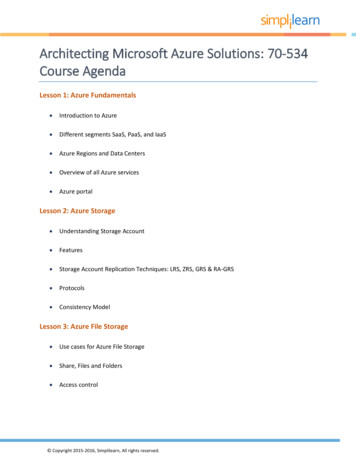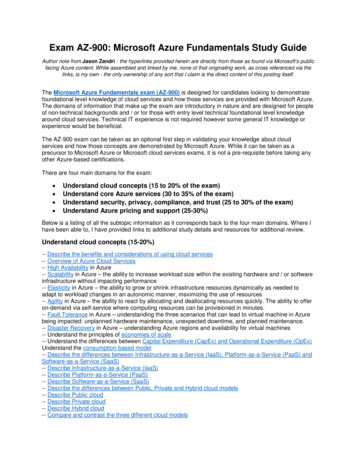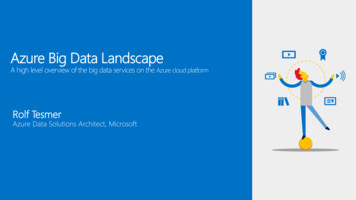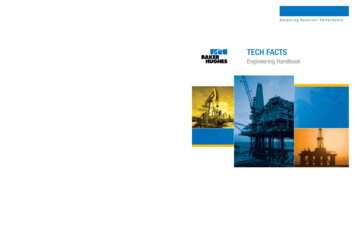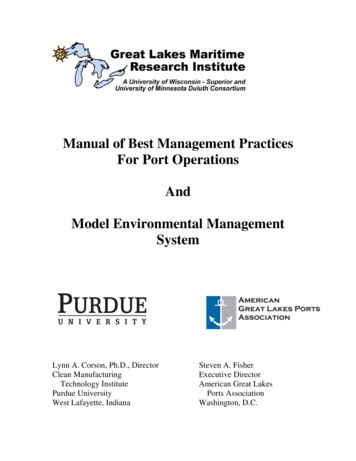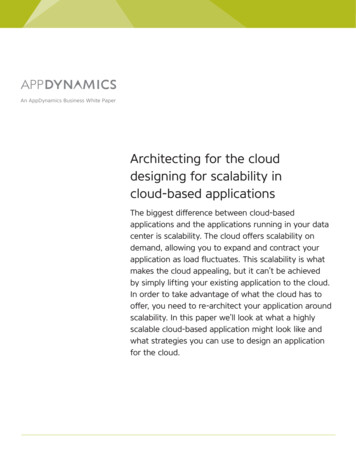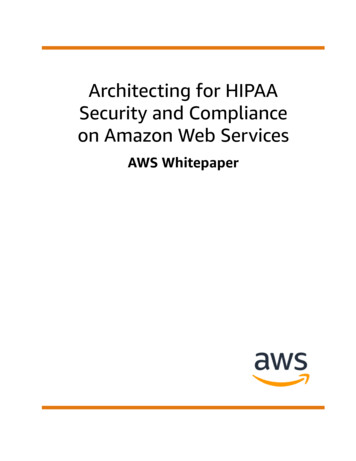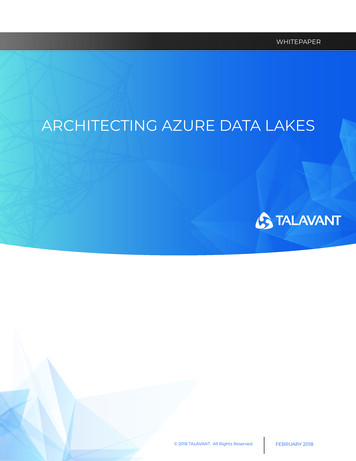
Transcription
WHITEPAPERARCHITECTING AZURE DATA LAKES 2018 TALAVANT. All Rights Reserved.FEBRUARY 2018
ABOUT TALAVANTMoving Information Forward.We exist because there is a better way to makedata work for business - better resources, strategy, sustainability, inclusion of the company as awhole, understanding of client needs, tools,outcomes, better ROI.We’re different. Not only are our methodsinclusive of all facets of a business – no matter thelevel of service you need, but we also commit toinvesting in our own knowledge and growth, andapply it to your people, processes andtechnologies.ARCHITECTINGAZURE DATA LAKESCONSULTANTS:Jordan AndersonSenior Manager of Consulting Services TalavantMadison, WISean ForgatchSenior Consultant TalavantMilwaukee, WI 2018 TALAVANT. All Rights Reserved.WHITEPAPER
TABLE OF CONTENTS1EXECUTIVE SUMMARYABSTRACTTHE CASE FOR A DATA NDESIGNData Lake ZonesSECURITYData Access ControlData SecurityData EncryptionOPERATIONSDATA MOVEMENTConceptsPlatforms and ToolsPROCESSINGProcessing ConceptsFilesTablesORCHESTRATIONOrchestration Concepts14DISCOVERYMETADATA AND TAGGINGConceptsMetadata TypesExploration15CONCLUSION 2018 TALAVANT. All Rights Reserved.WHITEPAPER
EXECUTIVE SUMMARYABSTRACTAs the volume, velocity, and variety of data grow, organizations increasinglydepend on data lakes for data storage, governance, blending, and analysis.A data lake enables organizations to collect a larger volume and variety of data without the rigidity andoverhead of traditional data warehouse architectures. Additionally, data lakes provide a place for data-focused users to experiment with datasets and find value without involving IT or spinning up a large project.This Whitepaper outlines the benefits of a data lake solution and defines an architecture for data ingestion,storage, curation, governance, and organizational distribution.THE CASE FOR A DATA LAKETraditional enterprise data warehouses (EDW)and data marts require planning, design, modeling, and development before data is madevisible to end-users. During this period, usuallydays to weeks, key elements in the business mayhave changed, requiring re-design and protracting time-to-value. EDW rigidity and rigor oftenentice end-users to build their own solutionsusing spreadsheets, local databases, and otherproprietary tools. This inevitably creates datasilos, shadow IT, and a fragmented data landscape. Furthermore, the scarcity of catalogedbusiness data resources limit the data that theorganization uses to answer business questions,resulting in decision makers acting on incomplete information.A well-designed data lake balances the structureprovided by a data warehouse with the flexibilityof a file system. It’s important to understand thata data lake is different than a file system in thatraw data cannot simply be added to the lake andmade available to the organization. Process anddesign are still required to enable end-users, andsecurity and governance still apply. The application of our recommended architecture willenable the data organization to be nimble whileretaining control.AUDIENCEWhile the beneficiaries of a data lake solutionspan the entirety of the organization, the usersthat access the lake directly are limited. Not allbusiness users will be interested in accessing thedata lake directly, nor should they spend theirtime on data blending and analysis. Instead, thewhole of the lake is made available to data scientists and analysts, while a vetted and curateddataset is made available to the organization atlarge. 2018 TALAVANT. All Rights Reserved.WHITEPAPER PG 1
ARCHITECTUREOVERVIEWThe overall architecture and flow of a data lake can be categorized into threeprimary pillars: data lake operations, discovery, and IGN patterns of our datalake are going to be the foundation of our future developmentand operations. Essentially, at thehighest of levels, you need a placeto land, stage, and surface data.The biggest difference betweentraditional systems is that whenwe land the data, it will live thereindefinitely. Though Azure DataLake is specifically designed forlarge scale analytics – and usuallyhoused on an HDFS platform – itcan also be built on Azure BlobStore or even SQL Server, depending on the specific use-case.DATA MOVEMENT involves theingestion and extraction of datain the data lake. Data might bepushed or pulled depending onthe technology chosen andpurpose for the movement ofdata. Ingestion is the most criticalcomponent as our source systemscan produce a variety of datastreams and formats.METADATA is the data aboutdata. This ranges from datalineage such as the format andschema, to capturing information about which source it camefrom, what day and time it wascaptured on, as well as the datalocation.SECURITY is necessary to enforcenot only compliance but also tokeep the lake from becoming a"data swamp" or a collection ofunorganized data within the datalake. Azure Data Lake allows usersto utilize Azure Active Directory tocontrol enterprise security as wellas security features specific toAzure Data Lake that controlsaccess.DATA PROCESSING, as it relates todata lakes, involve both real-timeand batch processing. This couldoccur both internally and externally to the data lake. The reason thisis included is that a streamingpipeline, in most cases, wouldroute both to a real-time dashboard as well as to the data lakefor later batch processing. Datavolume, velocity, and businessrequirements help determine theultimate pattern for processingdata.TAGGING is what drives datadiscovery in an organization. In adata lake, we could potentiallyhave petabytes of data. Much ofwhich might not be funneling toour production systems yet,because value has not beenidentified. Tagging is both anautomatic and manual businessprocess, and is unique to anorganization.ORCHESTRATION in essentiallycloud automation. Giving us theability to execute multipleprocesses on multiple systemswithin a data pipeline, andscheduling those pipelines. 2018 TALAVANT. All Rights Reserved.WHITEPAPER PG 2
ARCHITECTUREINGESTSOURCES Application Data ElectronicMedical RecordsSystems CustomerRelationshipManagement FinancialSystemsANALYZE & VISUALIZEDATA LAKE BYPASS-STREAMINGESTIONAZURE DATA LAKE STOREFILESTABLESRAWISTAGE Land quickly, notransformations Includes TransientData Operations Original Format Stored by DateIngested Tag and Catalog Data Possibly CompressedCURATED General Staging Conform DeltaPreparation DataMarketplace Data LakeStandard U-SQL/HiveTablesADF ANDPOLYBASER IoT Medical Devices Social Media Imaging Events VideoEXPLORATORY ExploratoryAnalytics Sandbox AreaMASTER Reference Data Data WarehouseData Archive DataDATA LAKE BYPASS-BATCH 2018 TALAVANT. All Rights Reserved.WHITEPAPER PG 3
1ORGANIZATIONDESIGNThe overall design of a data lake is vital to its success. Coupled with security and theright business processes, the data lake will provide valuable new insights; ultimatelyproviding more tools to executives for making strategic decisions.Nonetheless, if a data lake is designed poorly without a method of organization, it can quicklybecome a collected mess of raw data with noefficient way for discovery or smooth acquisition,and later increasing ETL development time, efforts,and limiting success.The first and foremost design effort should befocused on the storage hierarchy design and howdata will flow from one directory to the next.Though this is a simple concept, as laid out below, itwill set up the entire foundation of how a data lakeis leveraged from the data ingestion layer to thedata access layer.AZURE DATA LAKE ANALYTICSOPERATIONAL ZONESAZURE DATA LAKE STORERAWSTAGECURATED 2018 TALAVANT. All Rights Reserved.WHITEPAPER PG 4
Data Lake ZonesOPERATIONAL ZONESRaw Zone – This is the first area in the data lake where data is landed andstored indefinitely in its native raw format. The data will live here until it isoperationalized. Operationalism occurs once value has been identified bythe organization, which does not occur until a measurement has beendefined. The purpose of this area is to keep source data in its raw andunaggregated format. This may be that we want to start capturing socialmedia data, but don’t know just how we will use it. Access to this areashould be restricted from most of the business. Transformations should notoccur when ingesting into the RAW zone but rather the data should bemoved from source systems to the raw zone as quickly and efficiently aspossible.Data tagging is also included in this zone. This is where both automatedand manual tagging can be accomplished. Tagging of datasets can bestored within Azure Data Catalog. This will allow business analysts andsubject-matter experts to understand what data lives not only in AzureData Lake, but Azure at large.The folder structure for organizing data is separated by source, dataset, anddate ingested. Big data tools such as U-SQL allow for utilization of dataacross multiple folders using virtual columns in a non-iterative manner.Stage Zone – The Stage zone is where we land our data for processing andultimately prep the data to be loaded into a Hive or U-SQL table in theCurated Zone. Normal operations in this zone include decompression,cleansing, and aggregation. The results of these activities will often bestored in an output file. From here, the data can go two places, either to acurated table, or directly to an analytical store such as an Azure DataWarehouse, utilizing Polybase for data acquisition.SUPPORTING ZONESMASTER Zone – Master datawill always be trusted data andwill often source from the datawarehouse. This can alsoinclude archived data from adata warehouse if such practices are implemented. Thisdata is going to be used tosupport analytics within thedata lake.EXPLORATORY Zone – This isan open area where datascientists and analysts candiscover new value from thedata lake. They can leveragemultiple zones to find the bestpossible value from new data.This zone should be organizedby user and project.TRANSIENT Zone – Acts as atemporary zone and supportsingestion of the data. A usecase for this zone is that youmay want to decompress datain this zone if you are movinglarge amounts of compresseddata across networks. The datashould be short lived, hencethe name Transient.Curated Zone – The Curated zone is your trusted layer of data within thedata lake. It is now decompressed, cleansed, and ready for storage. This isyour database layer in either U-SQL or Hive. Data here are exclusivelyseparated by their own databases, and are conformed and summarized.This is the primary level of access to data where security allows for self-service BI and exploratory analytics. Depending on tool selection, data mayneed to be extracted back to a file for consumption outside of the datalake.The zones listed above account for the primary zones within a datalake. Apart from these zones are other supporting zones that may berequired to enable deeper analytics inside the data lake. 2018 TALAVANT. All Rights Reserved.WHITEPAPER PG 5
SECURITYIn1a big data solution, data must be secured in transit and at rest. There must be away to limit visibility for circumstances such as conforming to compliancestandards. Azure Data Lake provides enterprise grade security in the areas ofauthentication, auditing, and encryption.Data Access Control – There are two Access ControlLists within Azure Data Lake, Access ACLs andDefault ACLs. The Access ACL controls the securityof objects within the data lake, whereas the DefaultACLs are predefined settings that a child object caninherit from upon creation.At a high level, a folder has three categories of howyou can assign permissions: “Owners”, “Permissions”, and “Everyone Else”. Each of which can beassigned Read, Write, and Execute permissions. Youhave the option to recursively apply parent permissions to all child objects within the parent.Data Security – Role Based Access Control (RBAC)can be managed through Azure Active Directory(AAD). AAD Groups should be created based ondepartment, function, and organizational structure.It is best practice to restrict access to data on aneed-to-know basis. How that plan is laid outdepends on the specific security policy of the company. When designing a data lake security plan, thefollowing attributes should be taken into consideration.It’s important to have the security plan laid out atinception, otherwise, as stated above, applyingpermissions to items is a recursive activity. Accesssettings such as Read, Write, and Execute can all begranted and denied through the Azure Portal foreasy administration as well as automated withother tools such as Powershell. Azure Data Lake isfully supported by Azure Active Directory for accessadministration. 2018 TALAVANT. All Rights Reserved.WHITEPAPER PG 6
1. Industry specific Security – If you are workingunder HIPAA for patient records, it is required thatusers only have access to a patient’s record if it’s inconjunction with their specific role. So protectedhealth information (PHI) may need to be scrubbedbefore data can be surfaced for mining and exploration. If this is the case, it could change the security plan to be more restrictive.2. Data Security Groups – These should align withthe flow of the data through the data lake. Depending on how the data lake will be surfaced to endusers and services, data will be more restricted atingestion into the data lake and become moreavailable as it’s curated. The data should be asexplorable as possible without increasing risk.3. Apart from data security at the data lake storelevel, keep in mind the applications that will belayered over the store itself.For instance, Azure Data Lake Analytics, where youpay by the query. You will want production accessrestricted to the service accounts running thosejobs. Environments can be managed by creatingadditional Azure subscriptions.Data Encryption – Data is secured both in motionand at rest in Azure Data Lake Store (ADLS). ADLSmanages data encryption, decryption, and placement of the data automatically. ADLS also offersfunctionality to allow a data lake administrator tomanage encryption.Azure Data Lake uses a Master Encryption Key,which is stored in Azure Key Vault, to encrypt anddecrypt data. Managing keys yourself providessome additional flexibility, but unless there is astrong reason to do so, leave the encryption to theData Lake service to manage. If you choose tomanage your own keys, and accidentally delete orlose them, the data in ADLS cannot be decryptedunless you have a backup of the keys.KEY TYPES1. Master Encryption Key (MEK) – The ADLS Master Encryption Key stored in Azure Key Vault2. Data Encryption Key (DEK) – Encrypted by the MEK. Generates the BEKs for the data.3. Block Encryption Key (BEK) – Unique encryption keys generated for each block of dataassociated with an ADLS data file. The BEK is what’s used to decrypt the actual data. 2018 TALAVANT. All Rights Reserved.WHITEPAPER PG 7
2OPERATIONSDATA MOVEMENTData Movement includes primarily the tools, practices, and patterns of dataingestion into the data lake. Processing within the data lake and extraction out ofthe data lake can also be considered data movement, but much attention shouldbe directed at the ingestion level due to the various sources and tool typesrequired. A data lake is often designed to support both batch ingestion as wellas streaming ingestion from IoT Hubs, Event Hubs, and streaming components.Considerations1. Metadata – Metadata can be captured eitherduring the ingestion process or in some sort ofbatch post process within the data lake. A metadatastrategy should already be in place before dataingestion planning begins. The strategy shouldinclude knowing what data is going to be capturedat ingestion, which can be captured in Azure DataCatalog, HCatalog, or a custom metadata catalogthat will support data integration automation aswell as data exploration and discovery. The formatof the data is also important; what format will beused later in the data lake for processing? It may bemore beneficial to use various HDFS specific filessuch as AVRO depending on the scenario.2. Batch and Real Time – Azure Data Lake andassociated tools for HDFS allow you to work acrossthousands of files at petabyte size. A streamingdataset may place small files throughout the day, ora batch process may place one or many terabytesize files per day. Partitioning data at ingestionshould be considered, and is useful for gainingmaximum query and processing performance.Also consider that not all organizational data flowswill include a data lake. For example, SSIS packagesintegrate relational databases with your data warehouse.3. Cloud and On-Premise – Many organizations willwant to ingest data from both on-premise andcloud sources. It can sometimes be time-consuming to transfer large amounts of data fromon-premise systems to Azure. If this become abottleneck, Microsoft provides a private connectionto Azure via Azure Express Route. 2018 TALAVANT. All Rights Reserved.WHITEPAPER PG 8
PROCESSINGOnce ingestion of data has been completed, the next step is to begin anyprocessing of the data while it resides in the data lake. This can involve data cleansing, standardization, and structuring. Proper data processing tool selection iscritical to the success of a data lake.Within Azure, there are two groups of tools available for working with Azure Data Lake. Azure DataServices and Azure HDInsight. Though similar innature, one is not a direct replacement of theother, in some cases they directly support eachother just as a data lake can support an enterprisedata warehouse. For most cases, Azure DataServices will be able to solve the lower 80 percentof data lake requirements, reserving HDInsight forthe upper 20 percent and more complex situations. Azure Data Services is all about bringing bigdata to the masses, allowing organizations toacquire and process troves of data as well as gainnew insights from existing data assets throughmachine learning, artificial intelligence, andadvanced analytics. 2018 TALAVANT. All Rights Reserved.WHITEPAPER PG 9
Platforms and ToolsThe following diagram outlines the Azure Data Services and Azure HDInsight tools available for workingalongside Azure Data Lake. Though many modern tools have multiple functionalities, the primary use MVISUALIZEEXPLOREADLCopyAzure Data ServicesAnalysis ServicesAzure Data ServicesBlob StoreAzure Data ServicesData CatalogAzure Data ServicesData FactoryAzure Data ServicesData Lake AnalyticsAzure Data ServicesData Lake StoreAzure Data ServicesDistCpAzure HDInsightEvent HubsAzure Data ServicesHadoopAzure HDInsightHbaseAzure HDInsightHive/HcatalogAzure HDInsightHive LLAPAzure HDInsightIoT HubsAzure Data ServicesKafkaAzure Data ServicesPigAzure HDInsightPolybaseAzure Data ServicesPower BIAzure Data ServicesR ServerAzure Data ServicesReporting ServicesAzure Data ServicesSparkAzure HDInsightSQL Data WarehouseAzure Data ServicesSqoopAzure HDInsightSSIS-IRAzure Data ServicesStormAzure HDInsightStream AnalyticsAzure Data ServicesZeppelinAzure HDInsight Also provides orchestration 2018 TALAVANT. All Rights Reserved.WHITEPAPER PG 10
Part of designing a processing pattern across a data lake is choosing the correct file type to use. Listed in thebelow two diagrams are a list of modern file and compression types. It is often a trade-off between speedand compression performance, as well as supported metadata features.FilesFILE TYPECAPABILITYAvroCompressible; splittable; stores schema within the file;good for unstructured and schema differentiating dataParquet RC FileColumnar format; compressibleSequenceColumnar format and similar to compressible; splittable; packssmaller files into a Sequence file; improves processing in HDFSCSV/TextCommonly used in nearly every organization;easily parsed; often a good use case for bulk processing;not always best choice for HDInsight depending on use caseFile CompressionCOMPRESSION TYPECAPABILITYUSEBzip2High compression; low speed; works well forarchival purposes, not HDFS queriesArchivingGzipMid compression; mid speedAvro, SequenceLZOHigh speed; lower compression;works well for text filesTextSnappyHigh speed; lower compressionAvro, Sequence 2018 TALAVANT. All Rights Reserved.WHITEPAPER PG 11
TablesWhen processing data within Azure Data Lake Store (ADLS), it is a common practice to leverage fewerlarger files rather than a higher quantity of smaller files. Ideally, you want a partition pattern that will resultin the least amount of small files as possible. A general rule of thumb is to keep files around 1GB each, andfiles per table no more than around 10,000. This will vary based on the solution being developed as well asthe processing type of either batch or real-time. Some options for working with small files would be combining them at ingestion and expiring the old (Azure Data Lake has simple functionality for automaticallyexpiring files) or inserting them into a U-SQL or Hive table, and then partitioning and distributing thosetables.U-SQL and Hive processes data in Extents and Vertices. Vertices are packages of work that are split acrossthe various compute resources working within ADLS. Partitioning distributes how much work a Vertexmust do. An Extent is essentially a piece of a file being processed, and the Vertex is the unit of work.Table Partitioning in Azure Data Lake – Tablepartitioning within Azure Data lake is a verycommon practice that brings significant benefits.For example, if we have a directory that is distributed by month, day, and the specific files for that day,without partitioning, the queries would have toessentially do a full table scan if we wanted toprocess the previous month’s data. If we distributethis data by month, we would only have to read 1out of 12 partitions. Conversely, let’s say we weretracking orders of customers, we would not necessarily want to partition by a customer ID as thatcould result in many small files which would mostlikely be the contributor to increased overhead andhigh utilization of compute and memory resources.Partitioning considerations1. Partition Key should have a low number ofdistinct values2. Avoid partitioning until partitions would beat least 1GB in size3. Avoid too many small files 2018 TALAVANT. All Rights Reserved.WHITEPAPER PG 12
Table Distribution in Azure Data Lake – Table Distribution is for finer-level partitioning, betterknown as Vertical Partitioning. For our last example in discussing Table Partitioning, we reviewed when wewouldn’t use Table Partitioning for customer orders. We could however utilize Table Distribution for something more granular such as customers. Table Distribution allows us to define buckets to direct wherespecific data will live. In a WHERE predicate, the query will know exactly which bucket to go to instead ofhaving to scan each available bucket. Distribution should be configured such that each bucket is similar insize. Remember we still want to avoid many small files here as well.Incremental Updates in Azure Data Lake – How will updates be handled? In Azure Data Lake, we cannotupdate an existing file after it has been created like we would in a traditional relational database systemsuch as SQL Server. Instead, we need to load appended files, and construct our program to view/retrieve themaster set plus the appended file or just the appended file. This is what occurs when doing an INSERT.Utilizing a Hive or U-SQL table, we can lay schema across our data files as well as table partitions to drivequery performance and functionality. Sometimes it is a better approach to drop and recreate tables insteadof trying to manage many small append files.OrchestrationOrchestration – better understood as simply cloudautomation or job automation – is the process ofscheduling and managing the execution ofprocesses across multiple systems and the datathat flows through those processes.An example of a big data pipeline across Azurewould be ingestion from an Event Hub where weare capturing factory sensor data, processing thatdata through Azure Machine Learning and ]surfacing the results in a PowerBI dashboard in real-time.This entire process is orchestrated through AzureData Factory (ADF). We will refer to workflow automation as Orchestration. In the HDInsight environment, some tools are better suited to solving certainproblems than others. Therefore, an orchestrationsolution is what enables us to work across anever-increasing variety of technology and tools.It is a common misconception that ADF hasreplaced mature ETL tools such as SQL ServerIntegration Services (SSIS). ADF can be understoodas a higher-level orchestration layer that can calland pass data to other tools such as SSIS, U-SQL,Azure Machine Learning, and more. 2018 TALAVANT. All Rights Reserved.WHITEPAPER PG 13
3DISCOVERYMETADATA AND TAGGINGMetadata-capture and tagging are closely related, and support dataexploration and governance within the business.Metadata is what we talk about when capturing data about data, such as the source that the data originated from, how the data are structured and formatted, and when it was captured.Tagging is used to understand the inventory of a Data Lake through the notion of tags, similar to thoseattached to social media and blog posts. Consider a data lake in a healthcare organization is housing datafrom multiple electronic medical record systems. You might have a tagging strategy of EMR SystemName Patient Encounters (the dataset). This allows individuals throughout the organization to search forEMR system data by Tag.When devising a tagging strategy, the following should be considered: When does the data get tagged? Who will own and be responsible for tagging the data sets? What will the naming convention be so that data sets can be easily discoverable by other business units?METADATA MATURITY:Traditional Metadata – This includes information about flat files, tables,connection strings, file store location, file name, data types and length, etc. Youcan leverage this metadata in patterned ETL development and management.Modern Metadata – Utilizing file formats that allow metadata to be storedwithin a data file. Storing metadata within the file itself assists in solvingproblems such as evolving schema changes.Advanced Metadata – Automated processing and pre-defined aggregationsupon loading into the data lake. If you have worked with Microsoft’s PowerBIapplication, an example would be the Quick Insights feature that shows simplerelationships in the data and quick aggregations of the data. 2018 TALAVANT. All Rights Reserved.WHITEPAPER PG 14
CONCLUSIONData lakes are an important tool for organizations seeking data operationsflexibility and agility while retaining governance.Azure Data Lake empowers organizations to harness data without traditional database rigidityand overhead, drastically reducing time-to-value.Utilizing the foundational concepts and tools outlined in this Whitepaper, the implementation of asuccessful data lake will become an integral part of your organization’s data landscape and driveinnovation and performance through enhanced decision-making capabilities.THANK YOUMoving Information Forward.talavant.com 2018 TALAVANT.All Rights Reserved. 2018 TALAVANT. All Rights Reserved.WHITEPAPER PG 15
overhead of traditional data warehouse architectures. Additionally, data lakes provide a place for data-fo-cused users to experiment with datasets and find value without involving IT or spinning up a large project. This Whitepaper outlines the benefits of a data lake solution and defines an a
